Research Article
IMPACT OF AUGMENTED REALITY TECHNOLOGY ON CUSTOMER ENGAGEMENT IN EGYPT
4195
Views & Citations3195
Likes & Shares
Nowadays with the daily uprising innovations of technologies all over the world, augmented reality technology was developed and integrated to many different industries and can hugely impact consumer's engagements in various industries in Egypt. Conclusive descriptive research is conducted in a quantitative form. The target population will be highly educated university students as they are considered the youth of the community, the students social classes will be from social class A and B with high and higher middle incomes. The total sample of valid analyzed online questionnaires consisted of 152 participants mainly university students from both genders males and females drawn from private universities in Cairo. Findings clarified a positive relationship between augmented reality technology and costumers engagements in Egypt where the perceptions and mindsets of teenagers had changed to being more open and aware with new trending technologies. It is thus recommended to exploit augmented reality technologies in the shopping industry in Egypt, this will raise the consumers' engagement leading to increase in consumption and purchases consequently.
Keywords: Augmented reality, Engagement, Endorsement
INTRODUCTION
Nowadays, one of the major inventions in technology is the introduction of the augmented reality with its various impacts on consumer endorsement. With the help and contribution of Real and Virtual Technologies mixed up together, Augmented Reality is formed (Martins & Corea, 2015). It helped consumers to reach what they are looking for and what they really need in a natural environment (Martins, Guimaraes & Kirner, 2015). Today, inventions made the technologies move to new levels of intelligence leading to the interaction with consumers. This resulted from changing the old traditional ways of experiencing technologies to unique, special and different experience techniques (Tussyadia, Jung & Dieck, 2018). Amazon, Microsoft and Samsung are considered the pioneers to introduce various technologies; reality smart glasses, virtual mirrors and augmented reality applications (Rauschnabel, 2018). Basically the customers need to experience something new, something original and somehow present them the product/service they want in a visual real life examples through being technological oriented; by the help of e-commerce and digital media (Stoyanova, 2014; Khan & Brouwer, 2016). Yet, most of the company's focus on the normal known strategies (Braun, Hadwich & Bruhn, 2017). Augmented reality is mainly depending on generating mixed realities between the two worlds; the reality and the imaginative (fictional segment) (Yim, Chu & Sauer 2017).
LITERATURE REVIEW CUSTOMER ENGAGEMENT MEASUREMENTS AND OVERVIEW
As a result of the interactivity of customers to a specific product or service, customer engagement (CE) is formed. It is also related to the study of psychological and behavioral factors that affect the consumers in the market (Dessart, Veloutsou & Thomas, 2016; Hollebeek, 2011). Nowadays, customer engagements researches and studies are considered one of the most significant and vital aspects to marketers. It can affect some techniques they use paying consideration not only to the word of mouth marketing (WOM)which is basically the passage of information by oral communication between consumers but also to the way how customers engage by sharing their views on digital medias; electronic word of mouth (E-WOM) (Sharma & Sarmah, 2019; Cetină, Dumitrescu, & Vinerean,2014). In consequence to that aspect, consumers recently are considered and recognized as effective marketers, viral marketing strategy where companies depend on some consumers to spread their advertising campaigns through social networks platforms (Beckers, Doorn & Verhoef, 2018). In the past, all what companies cared about is the linkage between customer satisfaction and their quality of the product/service, presently they focus on customer engagement as a new concept (Hollebeek, 2011). Classical marketing techniques are not effective and creative as it was in the past, and can't be integrated to the present minds of the consumers. To be successful today, companies need to understand not only itscustomers, but it needs to recognize every stalk holder group that can affect the company; "followers, shareholders and external community" (Maslowska, Edward & Collinger, 2016). A part of customer engagement is the brand engagement, to gain a large percentage in a market for a specific brand (Terason, Pattanayanon & Lin, 2019). Recently, Nowadays, Brand engagements functions as a "worldwide consumer culture" (Vredeveld & Coulter, 2019). At the moment most of the financial institutes are at the risk of failure due to unstable, changing economic conditions prevailing around the world. Engaging with customers, have proven to be very useful and supportive for the survival of most kind of firms. There are two types of (CE) either direct or indirect ones (Kumar, Rajan, Gupta, & Pozza, 2019). Nevertheless peopleare discussing the components of the engagements either it focuses only on non-purchase decisions or it just includes all kinds of actions that a consumer will take (Maslowska, Malthouse & Collinger, 2016). (Beckers, Doorn & Verhoef, 2018). Added that CE concept is related and can affect both marketing and financial departments in any organization leading to an increase of effectiveness and efficiency. Engaged customer leads to several of positive outcome to companies including increases in sales volume, better competitive edge and a boost of profits. As engagements increases more between a firm and its customers, they become more loyal to the firm "Brand loyalty" (Hollebeek, Srivastava & Chen, 2019).Through the advances of technology platforms social media and online platforms, it is easier for firms to measure customer engagements changes (Gandhi & Tandon, 2015). (Cetina & Vinerian, 2014) mentioned that a firm's customer engagements levels depend mainly on the negative WOM where some complaining behaviors may affect the company customers greatly.
CUSTOMER TYPOLOGIES IN THE MARKET
In general a vital process to any business or a firm is market segmentation; which takes action by dividing the customers into various groups with common characteristics (Escobari & Hernandez, 2019). (Khan & Brouwer 2016) argued that there is many divergent of customer's types; first there is the uncertain buyer who is probably not sure and hesitates when taking a purchase decision. Secondly, there is the consumer who generally knows what he will buy and is already settled with a plan for his/her general purchases intention. Third there is the buyer who is very accurate and specific in his/her buying decisions. (Puiu, 2016) (Herstein, Drori, Berger, & Barnes, 2015) introduced also nine categories of customers among them; Talkative, Confident, Curious, Price Elastic, Quality Elastic, Shy, Hesitated, Hurried and the sociable type who loves to be kind and friendly to everyone all across the shop. However, (Herstein, Drori, Berger, & Barnes, 2015). Classified among the new digital customers some people who are new to the internet and social media in general "the Connectors". And people who don’t interact with the internet that often use the old traditional ways to buy a product; "the Simplifiers". "Bargain Shoppers" are in an extreme opposite side, those are the people who are addicted to the internet and the social media, their usage rates are enormously high. They are so much influenced by the advertisements, campaigns online and almost purchase everything through the digital channels (Zikiene & KalmakheIdze, 2016; Mishra, 2017). Regarding Loyalty, three types can be presented the disloyal customer who basically changes brands frequently in small time frame. To move to an extremely opposite side there is the highly loyal customer who is committed to a specific brand very much and is convinced that it is the best brand that satisfies his/her needs or wants. Between the two types, is "the Modest Loyal customer" who has some common characteristics and behaviors of the two types (Li, Yu & Matta, 2017). (Chang, Wu, Lee & Chu, 2018). mentioned that different customer types, comes from their various behaviors that sometimes result from gender differences, as the majority of males consumers processes information in a totally different way than female consumers. (Cornelia, Ioan, Sori, Ioan, Iasmina, Adrian, & Ciana, 2017). Was more interested in the demographical factors like the customer's family size, gender differences and the growth domestic product per head.
IMPACT OF DIFFERENTCOMMUNICATION TOOLS ON THE CUSTOMER'S MOTIVATIONS AND PURCHASING BEHAVIORS
Nowadays, all of people became marketers in their communities, which is a very important issue to be considered by firms. Companies also have another important point to tackle; knowing their customers or potential target market behaviors and motivations. In terms of behaviors, as a result of a company being online oriented in its campaigns and marketing strategies, this leads to two types of engagements of customers, either they do consider a purchase behavior and thus buy the product online or they are emotionally committed to a certain brand but doesn’t have the financial resources needed (Hilken, De Ruyter, Chylinski, Mahr, & Keeling, 2017). (Cetina & Vinerean, 2014). Costumers can be intensely loyal to a brand without trying its products in the actual world. A brand can do that by mixing personality traits with their advertisements. By mastering the ways to be effective in being online oriented, it will not only increase the effectiveness of the consumer to brand relationship, but it will also enhance the consumer to consumer (WOM). When a brand considers having strong online platforms, this leads to increase people recognition (Kaur & Paruthi, 2019).
Social Media made marketers to start planning customized strategies only for the mentioned platforms (Voorveld, Van Noort, Muntinga, & Bronner, 2018). Companies should align their campaigns on a specific social media platform. As every different platform offers a special advertising way; Instagram, usually focus on advertising by images, Snap chat, "sponsored lenses" offer aunique new take-on brand activation, providing special impressions as well as “play time" on snap chat. And for twitter their way is basically "short messages" (Pentina, Guilloux & Micu, 2018). By the increase in competition through digital platforms, discounts, offers and promotions are always there for companies to have competitive edges over each other's. Another strategy companies uses, is limiting the resources offered; "only two rooms left in this hotel" scarcity attracts customers as they feel they only have limited opportunity (Neunhoeffer & Teubner, 2018). By implementing the different digital communication strategies in the company's' efforts, this have hugely improved the levels of the gratification of consumers and enhanced the overall marketing performance of a firm (Lee & Lim, 2017).
THE ATTRIBUTES OF CUSTOMERS IN THE MARKETING PROCESS
In today's world, most of the top companies worldwide uses customer's characteristics and behaviors as considerable tool in their daily decisions. The firm's knowledge base of a certain kind of customer, comes from studying accurately the consumer's psychographics, demographics and behavioral characteristics. (Teubner, 2017). mentioned examples of some companies being specialized in using customer's information, taking advantages and considering this information in their strategic decisions; "Airbnb", "Bla Bla Car", and "Drivy" were some of the pioneers to do that in the past few years. Focusing on psychographics' characteristics, some companies dedicated most of its efforts on dividing consumer's motives into six smaller segments; financial benefit's, feeling of uniqueness, social experiences, privacy and risk concern issues also prestige levels. Then, analyzed strategies for each factor in a way to be competitive and attract consumers in the most effective way (Lee & Lim, 2017). Customers' products' awareness process includes the information gathered by consumers about a certain product lead to high brand awareness. Additionally, an application of that approach being used in real life situations is the Omni channel which is a multi-channel approach that helps the company/learner to know whether their target that they are focusing on is online earning mainly form; Computers, Mobile phones, or in a brick and mortar office (Beckers, Doorn & Verhoef, 2018). As a result of the newly technologies consumer attributes and behaviors can be tracked though the internet (Calder, Issac & Malthouse, 2016).
AUGMENTED REALITY
People started researching and developing in AR technology for a specific purpose, which is easing and reducing costs related to the representation of information to clients process (Tussyadiah, Jung, & Dieck, 2018). (Mclean & Wilson, 2019). People and companies don’t only use augmented reality technology because it saves costs and eases work processes only, but they also use it for a main organizational purpose, which is; showing quality and service excellence to customers (Huang & Liao, 2015). Augmented reality technology is a mutation of virtual reality (VR) technology, they have some common input features; "cameras", "video forms" and "GPS data" (Stoyanova, 2015). Some differences between the two technologies are: Augmented reality technology being more beneficial for users than virtual reality, however they have the same goal, which is to enrich the customer experience. While virtual reality focuses on presenting the real life situation, augmented reality customizes what the customer wants to see based on his/her preference (Yim, Chu, & Sauer, 2017). AR focuses more on the depth and on the quality of showing an object/information in many dimensions (Huang, Liao & Stoyanova, 2015). (Koenchan, 2018). (Amin, 2015). In the list of the top 10 strategic trends in 2018, AR is one of the main strategic trend (Flavian, Sanchez & Orus, 2019). (Salmon & Myhan, 2013). Both AR and VR have a common goal; to operate for the purpose of being cost effective (saving costs). Another common target for the two technologies is to be comfortable and easy for customer to use and avoid complexity. In terms of the market share and spreading of the technology, augmented reality is leading the way (Johnson, 2018). Analysts predict that AR technologies will outpace the VR in the future, because of many aspects one; of them is that recently it have been implemented in healthcare services and education industry. Also, famous companies as; "Apple", Facebook: and "Google" are now investing in it (Wiederhold, 2017). A further repeated benefit from both technologies is that they can support learning in any field or industry, better planning/creating a strategy and also they can have serious mentionable effects on investments, thus leading to a better performance of economies worldwide (Carl, 2018). However, both of VR and AR need high costly raw materials for the application to happen and with those new age technologies, companies benefit from new ways to learn and unique methods to perform their tasks which distinguish them from their competitors (Steffen, et al., 2019). It is noteworthy to relate their demand increase will lead to increasing the employment level in an economy (Altran & Manibo, 2018).
TECHNICAL COMPONENTS AND THEUSAGE OF DIFFERENT TYPES OF AUGMENTED REALITY
Devices which is compatible with augmented reality technology, read it and recognize it should have specific main components; the two vital requirements are "video cameras" and a "computer screen" (Rauschnabel, 2018). To make augmented reality technology more effective and efficient while preforming it's functions, it should also include "GPS technology" for some locations information, internet connection to be linked, sound sensors which identify also and detect sounds in the environment and "image recognition systems" (Koenchan, 2016). (Stonaya, 2015). (Rauschnabel, 2018). Another important process of augmented reality technologies is where real and virtual worlds are mixed together. This procedure is done through two ways, one of them is called "marker" which is basically interconnecting both worlds by depending on a marked location initiated by the device and the technology. On the other hand, there is the "markerless" which is a term that describes mixing both worlds using location based data from the internet; GPS technologies (Koenchan, 2016). (Amin, 2015). Illustrated that smart phones are used everywhere in the world making mobile augmented reality technology is in the top 10 list of the trending technologies in the world. Any smart mobile phone which is augmented reality friendly should include some needed hardware parts and software aspects (Kounavis, Kasimati & Zamani, 2012). Two main different types of devices categories are introduced to the market (Mclean & Wilson, 2019). First there is the internal devices which are represented generally by wearable augmented reality supported devices like; "AR Smart Glasses" like; Google glass, "AR Smart Watches" and "AR head attached displays (Mclean & Wilson,2019). (Rauschnabel, 2018; Amin, 2015). Furthermore, there is the external devices that consists of "stationary devices" like "Desktop computers", "Laptops", "Smart tablets" and smart phones which is augmented reality friendly. (Flavian, Sanchez & Orus, 2019; Rauschnabel, 2018).
IMPACT OF AUGMENTED REALITY MARKETING ON CUSTOMER ENGAGEMENT
Augmented reality technology can influence greatly customers in many various ways; it can greatly attract them in a purchase decision, that is done by this technology affecting the customers minds, thoughts ("Cognitive"), how they feel ("Emotions"), how they act ("Behavioral") and their sensorial towards a specific marketed brand/product (Flavian, Sanchez & Orus, 2019; Cox, 2017). IKEA stores adopted (AR) technology since long time ago to show the customer their unique Furniture's (products) in a very special way, boosting their sales and with it their profits (Johnson, 2018). A consumer perception to the idea of interactive systems and how this reflect an impact to a consumer behavior, attitude and emotions and ease of use illustrate the relationship among AR, customers’ satisfaction and endorsement and branding. This can be seen clearly in the case of car companies showing their new motor designs in an unprecedented way (Yuen, Yaoyuneyong, & Johnson, 2011). (Kaenchan, 2018). Added another example of makeup companies using the AR technology in their marketing campaigns; L'Oreal Paris makeup AR application using the Computer platform, helping women trying out their new appearances using the product.
THE IMPACT OF MIXED REALITIES TECHNOLOGIES ON CUSTOMER ENGAGEMENT IN DIFFERENT INDUSTRIES TOURISM
Tourism is one of the most important industries that benefited from that new wave of technology. Augmented reality offered significant fantastic experience to tourists in various destinations. It helps visitors to collect information about different field of interests and live different experiences. Augmented walking experience program is an example that is offered to tourists and give them the chance to feel like being exploring a touristic area without being really there (Tussyadiah, Jung & Dieck, 2017). Many other types of that technology had been also used in tourism. A device known as "360 degree video technology" head mounted that facilitates a wide 3D satisfaction is one of that prevailing examples. Others like "VR Set" was created for a purpose of customized tourist experience, consequently changing from eachtourist to another according to each one preferences and needs (Wagler & Hanus, 2018). Besides, "Street Museum App" is an application that uses the mobile camera through AR technology and guides the tourists by focusing the camera on a certain statue or monument and transfers the tourist from the present view of the camera to the history behind the site or the piece in the museum (Kounavis, Kasimati, & Zamani, 2012). Moreover, "Tuscany" is an application that serves as a tour guide that offers information search with multi customized language as preferred by the tourist. This information is easily translated to the preferred language as demanded by the tourist through AR technology. Street Museum App and Tuscany are said to claimed to threaten the tour guides' jobs (Tussyadiah, Jung, Dieck, 2017). (Amin, 2015). Leading to guides unemployment. Thus, ordinary Mediation (guided tours) has been changing to technological Mediation (Munar, 2010).
However, benefits of AR applications should not be ignored as they offer a high quality service in tourism leading to a more satisfied tourist who will definitely not only will repeat his enriched experience, but also will be serving as a positive "Adprosumer" who reviewers will depend on (Hassan, 2000). Clarified some negatives of the technology to tourists presented in less emotional involvement with the sites visited and no social interaction with the locals. These applications reduce the movement and activities of the tourists and that may lead to many health complications. Yet, that same drawbacks may play a positive role if used by handicapped tourists which will help them to explore many touristic places (Wagler & Hanus, 2018).
EDUCATION
Nowadays, one of the most important concerns worldwide is education; people are so motivated to learn in different ways. They are changing the traditional way they used to follow to more flexible technological methods. VR and AR are both good examples of those modern techniques. Teaching different languages through augmented reality is a technique that spreads the languages in a very enjoyable manner. (Salmon & Nyhan, 2013). Mentioned that a new AR language application called "SSAT.AR Quizzes "that has an academic language base that is used by teachers or students in the education process to scan any word and translate it into the preferred language. It also promotes the interaction and the participation among users. (Kaenchan, 2018). Stressed that the most significant industry where the AR is very clear and beneficial is the Education Field. Augmented reality helped in academic lectures transforming them from just dull static ones to interactive enjoyable ones. Also (ElFord,2013) mentioned that AR technology through "Bug-in-Ear Coaching AR technology" helps in immediate feedback to teachers before and during the teaching process by automatically detecting voices by "voice sensors" and auto corrects words, definitions and information. In a study conducted by (Zarraonandia, Aedo, Díaz, & Montes, 2014). concluded that AR technology boosts the cognitive learning process of students and helps them to participate and interact efficiently in the study room Augmented reality is also implemented in book making industries; like the: "Zoo burst application" where students customize their favorite books in a 3 dimensions way which helps them express what they think and present it in a more creative way (Salmon & Nyhan, 2013; Kaenchan, 2018). Added that there is a new entertaining way related to the education process based on AR technology; games which provide a unique environment and learning interaction environment among students.
HEALTH- CARE
One of the very serious and vital industries that are positively influenced by AR technology is the health care industry. Pharma3D is a study conducted by (Elizondo, Lazaro & Garcia, 2017). Stated that patients should be more inspired and happy while being treated, this is achieved through AR that helps in improving the effectiveness and the quality of the medical performances. It also boosts the safety of patients treated. A significant application is "Babylon" AR application gives precise information and track specific aspects leading to solve health problems before severe health conditions. This is carried out by holographing organs and most of the body systems. (Wiederhold, Miller & Wiederhold 2018). Clarified that a recent revolution occurred globally by AR technology, helping in curing many critical diseases and contributed in treating and diagnosing many health cases easier. Chemo therapy and burning wounds are best mentioned examples (Gupte, 2019). Stressed the fact that the diseases are continuously evolving nowadays causing enormous threat and danger to human lives. He discovered that the only solution for confronting those effects is the AR technology. AR health apps are trending nowadays and their usage provides higher accuracy and timely precise information related to any medical process. Another important tool using AR in operations is the "AR Smart Glasses" "Microsoft hollo lens"; this tool benefited the doctors while operating any patient by improving their performance through using extra help that is represented by a third hand. Also, the glasses have either audio (voice commands) or physical stimulus (eye blinking) that saves time and efforts to save lives of people where a second means a life (Klinker, Wiesche, & Krcmar, 2019). Some psychological treatments are offered by an AR app called "Pisious AR App"; that helps in solving a disease called "Parkinson"; a progressive disease of the nervous system showed by muscular rigidity and slow imprecise movement affecting mainly middle aged and elderly people. A Rtechnology is also very helpful in emergency non planned cases; by showing emergency equipment in a medical room when needed in the worst case scenario (Elizondo, Lazaro & Garcia, 2017). In conclusion, technological advancements and AR integrated in health care services emerged to be a positive efficient type of technology (Wiederhold, Miller & Wiederhold, 2018).
SHOPPING INDUSTRY
(Warner, 2012). mentioned that AR is not only used in food groceries' stores, but it is also widely spread in different types of stores; stores than often present technical devices, rely on augmented reality. Augmented reality devices, can really contribute to enhance the overall performance of any retailer type. Highlighting the effects of some AR devices, which have the effects to provide a virtual prototype of product or a service, for the customers to try and experience before their final purchase decisions (Wiebach & Send, 2019). It is also used in the trendy part of today's life; Fashion. Fashion retailers uses augmented reality to show the unique designs of their products and make sure that the consumer gets the company unique selling point that distinguish a company from its competitors. One other aspect which AR technology is used in, is substituting the physical fitting rooms with a virtual more creative, easier ones that saves time and efforts for the customers (Miell, Baek, Yoo & Yoon, 2018). (Mclean & Wilson, 2019). Mentioned that customers in general feel more satisfied and involved in a process which are presented in a three dimensional interactive way more than an ordinary two dimensional one.
Furthermore, AR technology is used in a variety of many training processes where the trainee is benefited by using this new technology in his classes; training pilots use augmented realty flight stimulators to have courses about the functionality of planes and components. Another industry is also privileged to have the AR technology; like police departments that use "hand-eye coordination AR" to train police officers to increase the speed of their reflex actions in their daily tasks. Military and national defense departments use this type of technology in a virtual environment to test and train their soldiers (ElFord, 2013).
MIXED REALTIES EFFECTS ON CUSTOMER ENGAGEMENT IN DIFFERENT COUNTRIES
Nowadays most of the countries around the world are responding to the fast advances of technologies in general which is related to the overall country's performance in the economy. In Germany, "Germany Trade and Investment" Agency (GTAI) mentioned that Germany is trying to adapt with all most kind of new technologies, including augmented reality technology and in 2021, eighty percent of the supply chains of organizations will be fully digitalized. The European union have recently discussed the importance of technological factors; "machine to machine interaction", three dimensional printings and other new creative technological innovations and how they greatly impact every country's economy in the region (Davydof & Riabovel, 2019). In America, Harvard University identified and described augmented reality technology as one of the most important technologies that will be considered in the future. Some American worldwide companies invested enormous amount of money to acquire AR and VR technologies and implement them in their business; "Facebook" organization spent approximately 2 billion dollars in VR startup oculus. Microsoft also spent 150 million dollars to invest in AR technologies; Google and apple were involved in joining the new trend of the worldwide market as well (Verdeveld & Coulter, 2018). (Kaenchan, 2018). Said that augmented reality technology is being seriously studied in Thailand in Asia content. Recently, some major researches are conducted to implement this vital technology into the Thai education systems to enhance the effectiveness and the communication factors in the learning process, not only does the research contribute to Thailand economy but it does help the overall performance of Asia content. Other fields that augmented reality impacted in Thailand was; training of workers, medical services and were used in marketing to increase customers satisfaction levels. In USA, Japan and Italy food presentation have hugely changed in terms of its techniques, as those three countries used augmented reality technologies in boosting their food retailing business, to show certain aspects that the consumer eyes don’t usually see and recognize (Koui, 2017).
RESEARCH CONTRIBUTION
RESEARCH AIM AND OBJECTIVE
RESEARCH AIM AND OBJECTIVE
This study is conducted on the purpose of understanding how costumer endorsement is a vital aspect for today different types of businesses (Beckers, Doorn & Verhoef, 2018). And the primary focus of the study is related to analyze the effect of augmented reality on consumer's behaviors and how it impacts their experiences during or after a purchase decision in various industries, and how they perceive this new technology (Tussyadiah, Jung & Dieck, 2017).
RESEARCH GAP, QUESTIONS AND HYPOTHESES
According to the previous literature discussed, it was apparent that there were no extensive studies conducted to understand in details the Arab region and Egypt in specific. Hence, the aim of the study is to evaluate the impact of using that kind of technology in enhancing the expectations and experiences of the customers in Egypt. Consequently, the role of different elements of AR had been measured on different aspects which are: ease of use, level of engagement and future relationship investment. So the two variables included are first the augmented reality technology which is the independent variable and second the customer experience which is the dependent variable.
WHAT IS THE IMPACT OF AUGMENTED REALITY TECHNOLOGY ON CUSTOMER EXPERIENCE?
Augmented Reality technology has a direct relation with the customer' experiences, thus leading to repetition of visits.
CONCEPTUAL FRAMEWORK
The conceptual frame work diagram below explains the purpose of the research paper which is to examine the effect of augmented reality technology on consumer's experiences (Figure 1). It was mentioned that the augmented reality affects many aspects in the experience of consumers, one of which is the engagements of consumers when experiencing this technology while shopping and how it enhances their shopping experiences (Wiebach & Send, 2019).


RESEARCH METHODOLOGY
RESEARCH DESIGN
Basically, one of the most vital process in the marketing research is the research design. A prove of the efficiency and precession of the paper is shown by the research design. Exploratory and conclusive are both examples of different styles of research designs. Exploratory research design is aims mainly for small sample numbers which doesn’t not represent the total population and is used mainly for the purpose of giving some perceptions and understating for the topic. Diversely there is the conclusive research design which basically targets to test the relationship and correlation between certain variables in order to answer the research questions and test the suggested hypothesis, this is done by acquiring a large and indicative sample (Malhorta, 2010).
Descriptive and casual researches are the two divisions of the conclusive research design. Mainly descriptive research will be used and is concerned with describing a specific characteristic, one the other hand casual research is related to the identification of a cause and effect relationship between certain variables. (Cooper & Schindler, 2008). In this research paper, a conclusive research will be adopted in order to be able to provide an adequate and valid answer to the previously stated research question, how augmented reality may enhance the customer experience relating it to highly educated students, specifically in the Middle East focusing on Egypt The conclusive research design is the most appropriate when testing and examining relationships and features. Moreover, a conclusive research shows and gives results that can serve as input into decision making process. In order to understand the effectiveness of augmented reality technology on consumer's experiences in Egypt, a descriptive research has to be carried out for a main purpose which is describing the role of AR elements in shopping consumers' experience.
RESEARCH METHODS
Quantitative research was specifically chosen in order to describe, explain and predict the effect that would help the integration of augmented reality with different customer's experiences.
SAMPLING DESIGN PLAN
So, in general the sampling process is used as it has the benefits of generalizing the results for the whole population. The main target population will be highly educated university students as they are considered the youth of the community, the students social classes will be from social class A and B with high and higher middle incomes, (Gandhi & Tandon, 2015). Recommended to obtain the highest reliability and validity higher top social classes groups should be selected to be the majority of the sample population. This research focused more on Cairo as generally the highest income and highest social classes are found in the capitals. Distributed to private sector universities as they represent the highest education systems, also they represent the majority of high income students. The reason for choosing the sampling unit is mainly for convenience.
THE SAMPLING TECHNIQUE
Sampling technique is the third step of the sample design process. The sampling technique chosen is the non-probability sampling technique as each individual in the population has no probability of being chosen randomly and it is based on convenience (Cooper & Schindler, 2008). The sample technique was selected because of its frames. A convenience sampling approach will be adapted as it is the least time consuming, easy to measure, and accessible. (Malhotra, 2007).
THE SAMPLE SIZE
The fourth step in the sampling design process is the sampling design. In this research the total sample will consist of 152 participants mainly university students from both genders males and females drawn from private universities in Cairo. The social classes of the sample will be mainly from the higher and middle class with high and middle income levels since it is the most suitable class for the research.
THE DATA COLLECTION PROCESS
THE DATA COLLECTION PROCESS
Sampling design process is the execution of the sampling process. Procedures were carried out in two months period. English versions of questionnaires are used as it the most suitable language for the higher and middle class. Then the questionnaires will be online distributed among private universities.
INSTRUMENT DESIGN
All the scales used in the questionnaire will be presented with their corresponding variables thus the main aim is to describe the relationship between those variables; the relationship between the two main variables, augmented reality and customer engagement. This instrument was adapted from (Yim, Chu, & Sauer, 2017).
QUESTIONNAIRE
The questionnaire consisted of 26 questions in the start of the survey a filtering question was asked to examine if the respondents experienced augmented reality technology before or not. Then moving to the first sector which is related to the first variable, what is your sense of the physical place, three questions were developed. In the second sector it was related to the engagements levels of respondents to the augmented reality technology. Moving to the third part which is related to the third variable, whether the respondents displayed the environment to be natural or not. . The Fourth sector is related to the negative effects the experienced while using the technology. In the Fifth there was the ease of use sector which basically means how easy is the technology to be used by the consumers sixth there is the future involvement with technology, and it's basically related to how will the consumers behaviors and attitudes towards the technology changes after experiencing it for the first time. In the seventh sector repetition of use is discussed. All the questions in the questionnaire are 5 levels Likert scale except for questions 1, 24, 25 and 26.
DATA ANALYSIS: RESULTS AND DISCUSSION
Descriptive Statistics
Descriptive Statistics
The sample compromises 50% Females and 48% Males. With regards to the age the sample includes 92.1% falling in the category of 18-25 years olds. In addition the age category of 26-30 compromises 3.9% of the respondents. And respondents falling in the category of 31-40 compromises 2.6% of respondents. Respondents In the age category above 40 represents 1.3% of respondents. Regarding respondents in the income bracket of 1000-5000 they represent 77% of the respondents in addition the bracket of 5000-10000 represent 12.5% of the respondents. Respondents who get over than 10000 income monthly represent only 10.5% (Table 1).
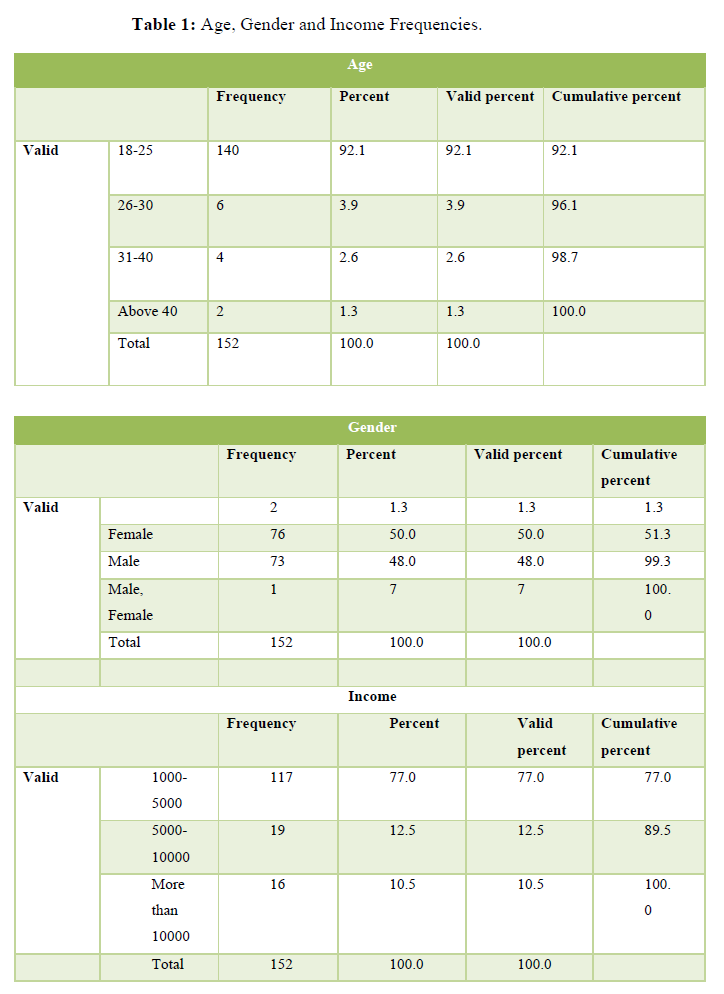

On the question asking about the sense of being in the scene displayed, the majority of respondents 36.8% stated that they are neutral. Also 15.1% of respondents stated that they strongly agree. 30% of respondents agreed and 11.2% disagreed while 6.6% strongly disagreed (Table 2).
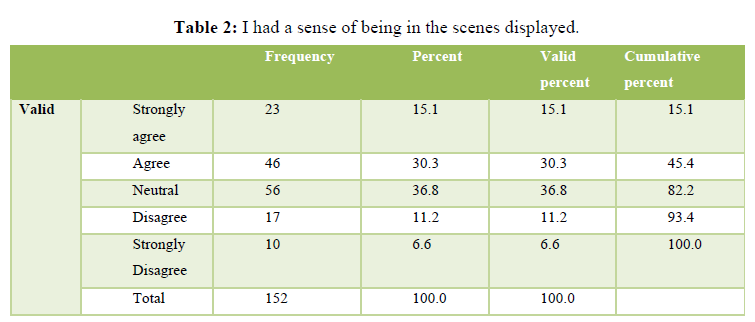

On the question about the feeling of visiting the places in the displayed/artificial environments the majority answered the question choosing the neutral choice. People who disagreed were only16.4% followed by the least percentage of respondents who answered the strongly disagree choice and their percentage was the least (6.6%) (Table 3).
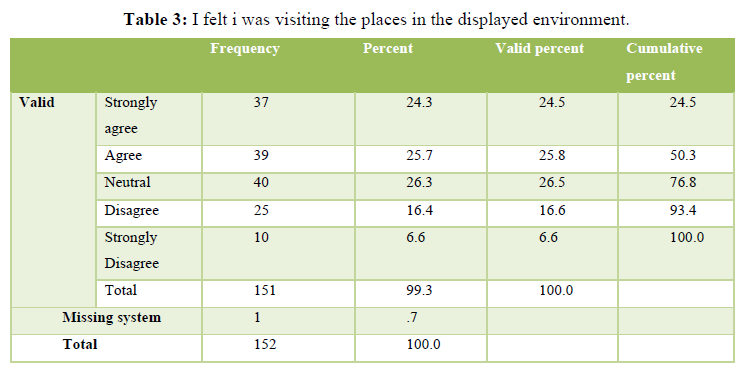

The majority of the respondents who thought that the objects and characters could almost be touched were the respondents who stated that they agree with the highest percentage (27%). Followed by 25% of respondents who stated that they strongly agree with the stated question. And then after that comes the respondents who were neutral (23%). Respondents who disagreed were 17.1% and the lowed percentage comes with the respondents who strongly disagreed 7.9% (Table 4).
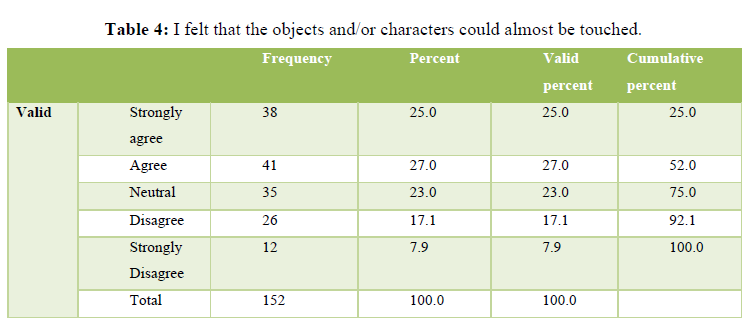
This question is related to the feeling of being involved in the displayed environment, respondents who have negative feelings were the minority with 17.8% who disagree and only 8.6 % who strongly disagree (Table 5).
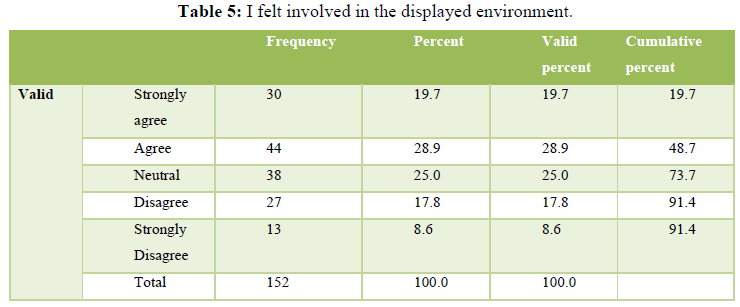

The population sample mostly enjoyed while experiencing AR technology with a percentage of almost 75.7 (Table 6).
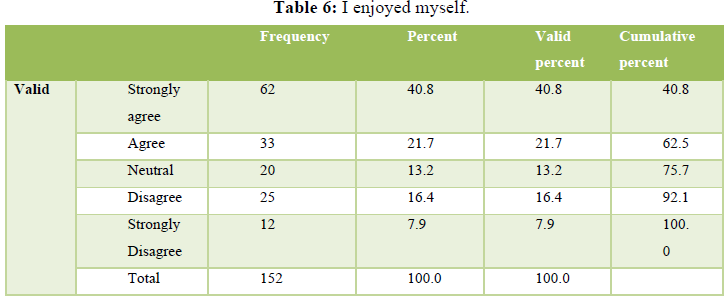

Those who have not passed a strong experience with the AR technology were only a tiny percentage 27.7 (Table 7).
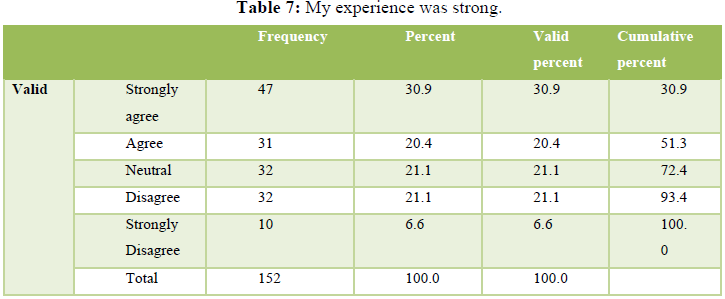

In this question respondents were asked about who much the content seemed believable to them. The majority of respondents accept with about 75% (Table 8).
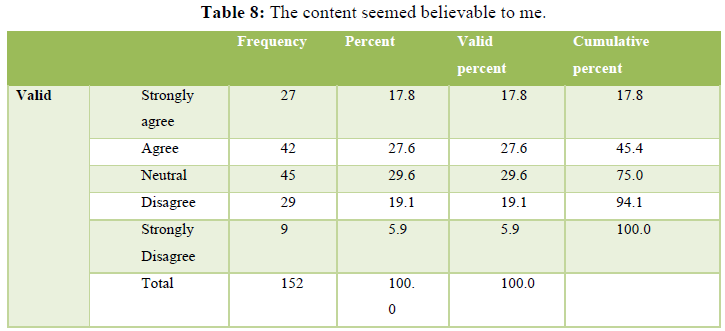

The majority 31.6% were natural followed by the respondents who agreed (25%) and then came the respondents, who strongly agreed that the displayed environment seemed very natural to them (19.1%) (Table 9).
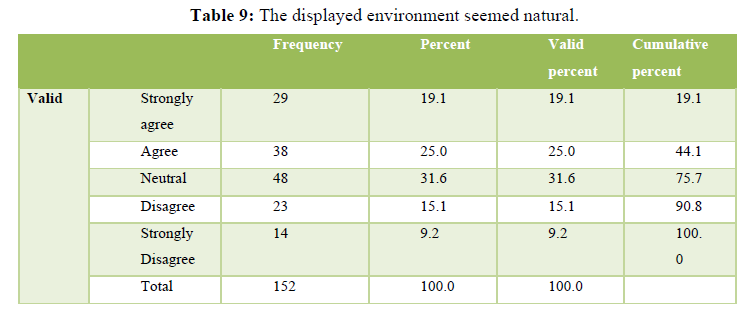

One of the advantages of using AR technology is that customers feel and enjoy the presence of things and that coped with the large sample percentage which agreed with about 79% (Table 10).
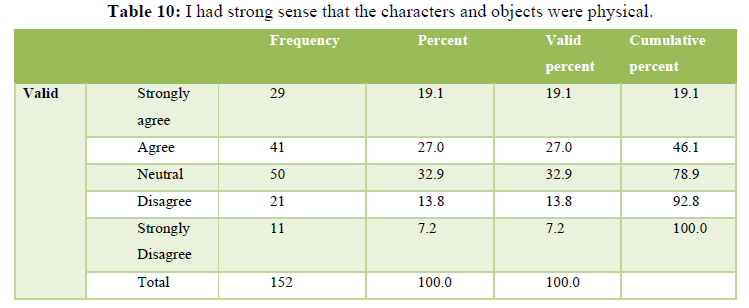

This question asked about the dizziness levels and did they feel light headed after the experience. Here almost half of the sample felt so while the others contradicted. This may lead to say that this technology has to be developed to overcome such problems that may occur (Table 11).
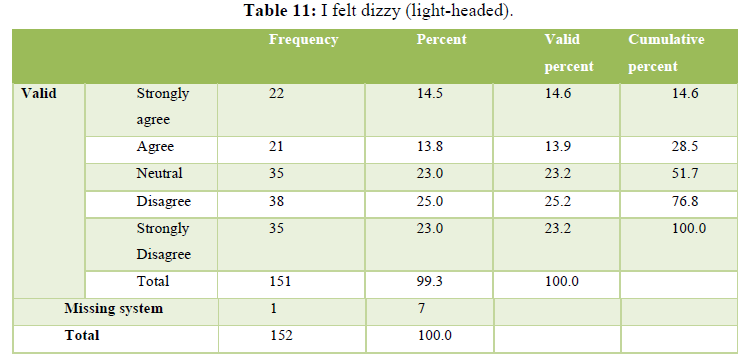
A large percentage of the sample were not against the technology and that it leads to some organic disorders (Table 12).
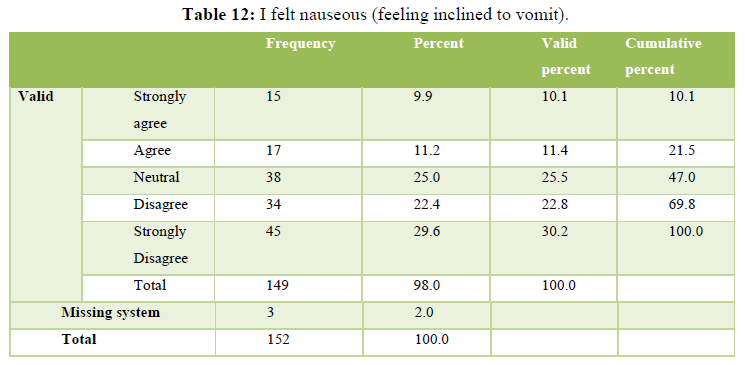

Almost half of the sample denied the feeling of headaches with25.7% who disagreed and 32.2% who strongly deny (Table 13).
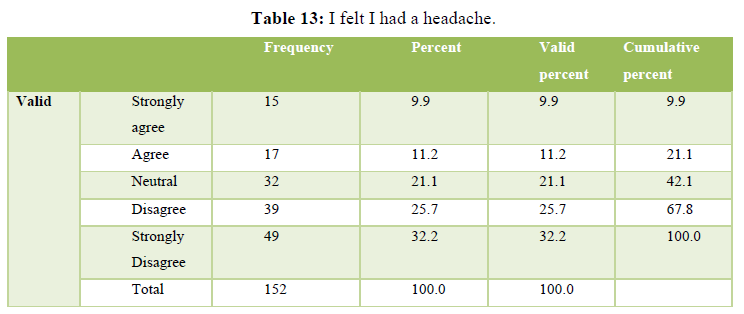
Eye Fatigue during AR usage was experienced by almost 57.9% of the sample (Table 14).
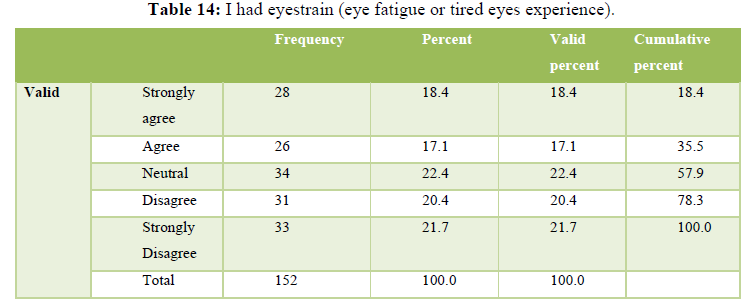
Mental effort required was stated by almost 67% of the sample (Table 15).
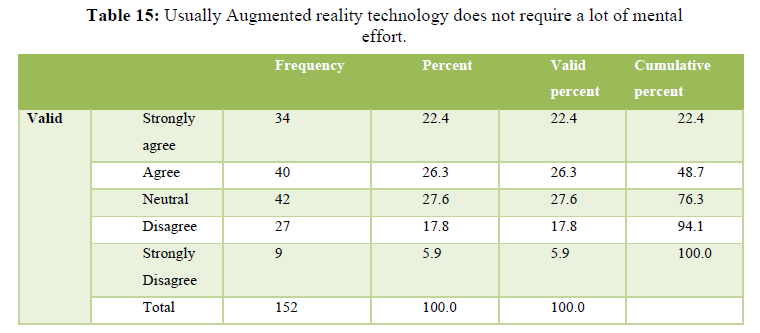

Mental effort required was stated by almost 67% of the sample (Table 15).

Ease of Use was assured by most of the users by 81.6% and this will be an encouraging start for the extensive application of that technology (Table 16).
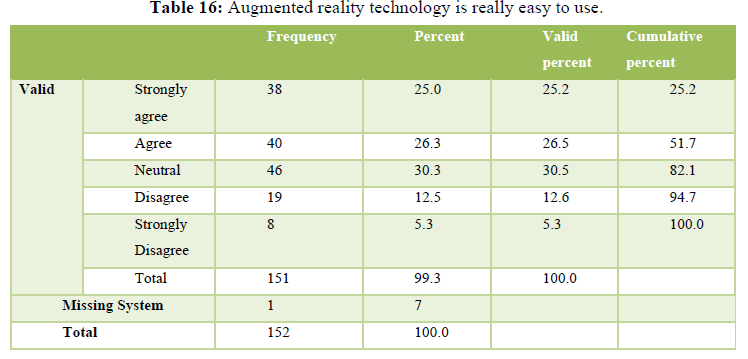

The majority of the population sample around 83% assured that AR technology will help and minimizes the human's effort in the future (Table 17).
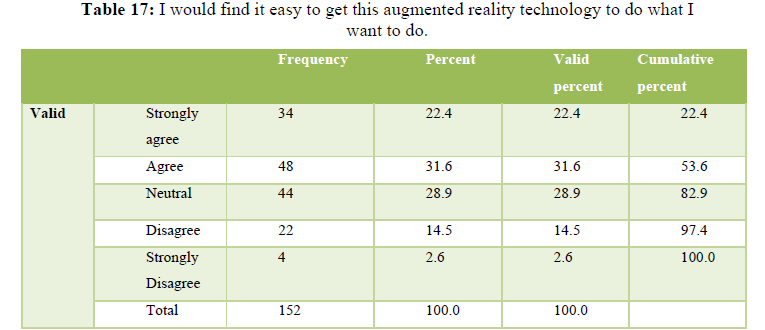

Only 33% answered in the negative refusing to devote part of their time and effort to experience that technology (Table 18).
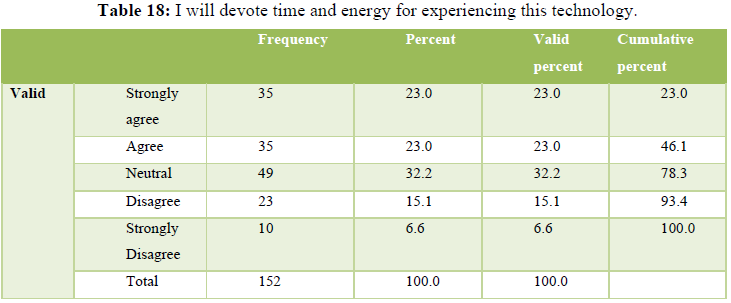

The majority of the sample will help in spreading the idea of that technology with a percentage of 79 (Table 19).
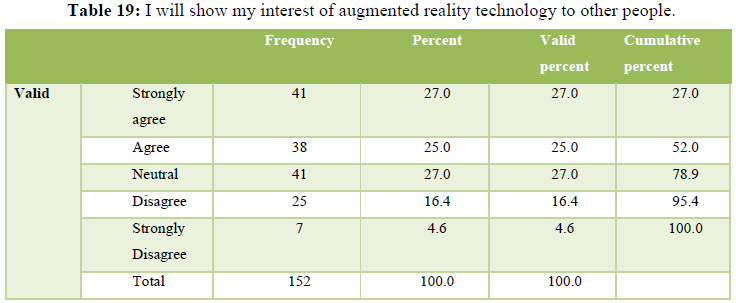

Probably that those who welcomed the idea to spread AR technology among others will also have no reason not to help with information needed and that was very clear among the sample with a percentage of 78.2 while only a tiny percentage were on the other negative side 21.7% (Table 20).
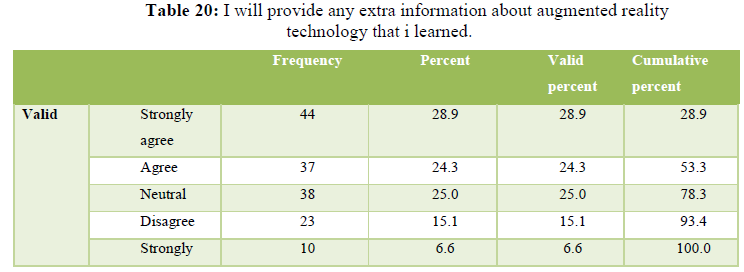



This question asked about whether respondents will experience augmented reality technology again or not. The highest percentage of the respondents strongly agree 42.8% followed by 21.1% of respondents who said that they agree making about 62.9% approval. In addition to 17.1% of respondents who were neutral (Table 21).
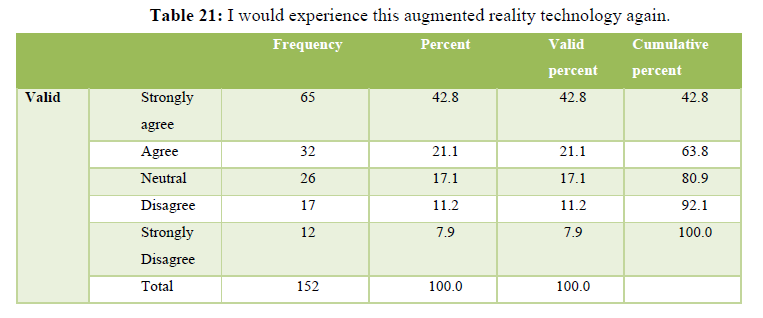

CORRELATIONS
Pearson correlation coefficient was used to examine the relationship between augmented reality and customer experiences. This correlation showed that is significant as its Pearson correlation value is greater than < 0.5, also as there is no negative sign next to the Pearson correlation number then correlation is positive. As the r value which is named in the correlation table as "Pearson correlation is between the range of 0.50 to 1.0 this shows that the strength of the relationship between the two variables, augmented reality and customer experiences is strong. This means the more the consumers use the augmented reality technology and the higher their consumer experiences gets (Table 22).
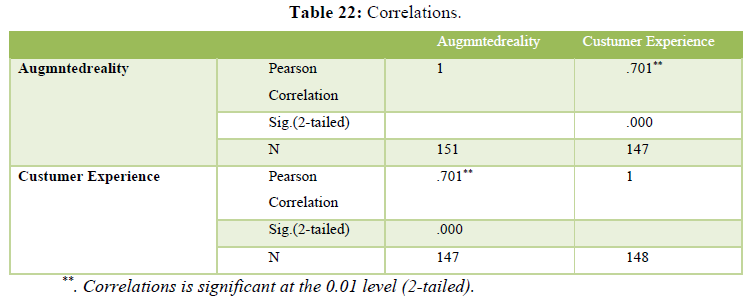

Research Conclusion
A survey was undertaken and data was analyzed by the SPSS software. Basically the effect of augmented reality technology on the consumer's experiences and engagements were studied and examined. A positive correlation between using the AR technology was discovered in different industries; tourism, health care, fashion, shopping and even education. Mixed realties effects on customer engagement in different countries were also analyzed. Augmented Reality is mentioned to have positives but also some draw backs that have to be confronted and eliminated should this technology come heavily in practice.
Managerial implications and recommendations
Relating to the research findings, the majority of the respondents in Egypt showed a positive behavior towards using augmented reality technology. Marketers nowadays can increase the use of augmented reality technologies in general in some industries; shopping industry and that can be done by integrating this technology with their sales promotions which include product samples, purchase displays, point of purchase and contents all of those sales promotions can be used with augmented reality glasses to increase the effectiveness of the experience to the consumers and thus increase sales by delivering a new unique creative way.
- Amin, R.K. (2015). Augmented experiences what can mobile augmented reality offer museums and historic sites. Doctoral dissertation university of Calgary, Calgary, AB.
- Baek, T.H., Yoo, C.Y., & Yoon, S. (2018). Augment yourself through virtual mirror the impact of self-viewing and narcissism on consumer responses. International Journal of Advertising 37(3), 421-439.
- Beckers, S.F., Doorn, J., & Verhoef, P.C. (2018). Good better engaged the effect of company initiated customer engagement behavior on shareholder value. Journal of the Academy of Marketing Science 46(3), 366-383.
- Braun, C., Hadwich, K., & Bruhn, M. (2017). How do different types of customer engagement affect important relationship marketing outcomes an empirical analysis. Journal of Customer Behaviour 16(2), 111-144.
- Busalim, A.H., Hussin, A.R.C., & Iahad, N.A. (2019). Factors influencing customer engagement in social commerce websites: A systematic literature review. Journal of theoretical and applied electronic commerce research 14(2).
- Calder, B.J., Isaac, M.S., & Malthouse, E.C. (2016). How to capture consumer experiences: A context-specific approach to measuring engagement Predicting consumer behavior across qualitatively different experiences. Journal of Advertising Research 56(1), 39-52.
- Carl, D.R. (2018). The Shifting Realities of Performance Improvement VR AR MR Performance Improvement. 57(4), 6-9.
- Cetina, I., Dumitrescu, l., & Vinerean, S. (2014). Exploring consumer engagement in an esetting a qualitative research of marketing executives. Economic Computation & Economic Cybernetics Studies & Research 48(2).
- Chandra, S., & Kumar, K.N. (2018). Exploring factors influencing organizational adoption of augmented reality in e-commerce: Empirical analysis using technology-organization-environment MODEL. Journal of Electronic Commerce Research 19(3).
- Chang, C.T., Wu, Y.C., Lee, Y.K., & Chu, X.Y. (2018). Right metaphor right place choosing a visual metaphor based on product type and consumer differences. International Journal of Advertising 37(2), 309-336.
- Cornelia, P., Ioan, B., Sorin, M., Ioan, P., Iasmina, I., Adrian, F., & Ciana, M. (2017). Types of consumers of agroturism. Agricultural Management lucraristiintifice Seriai, Management Agricol 19(1).
- Corrêa, A.G.D., Nascimento, M., Ficheman, I.K., & Lopes, R.D. (2012). Contributions of an augmented reality musical system for the stimulation of motor skills in music therapy sessions. Learning disabilities 1, 275-288.
- Davydov, D.S., & Riabovol, D.A. (2019). Innovation in the Sphere of Augmented and Virtual Reality Technologies in EU Member States and Other Countries of the World. Problems of Economy 39(1).
- Dessart, L., Veloutsou, C., & Thomas, A. (2016). Capturing consumer engagement: Duality, dimensionality and measurement. Journal of Marketing Management 32(5-6), 399-426.
- Elford, M.D. (2013). Using tele-coaching to increase behavior-specific praise delivered by secondary teachers in an augmented reality learning environment. Doctoral dissertation, University of Kansas.
- Escobari, D., & Hernandez, M.A. (2019). Separating between unobserved consumer types evidence from airlines. Economic Inquiry 57(2), 1215-1230.
- Flavián, C., Sánchez, S.I., & Orús, C. (2019). The impact of virtual, augmented and mixed reality technologies on the customer experience. Journal of Business Research 100, 547-560.
- Gandhi, P., & Tandon, N. (2015). Understanding CRM as a major data analysis mode to improve customer experience crm and its alignment with technology. Management 17, 18.
- Gupte, N. (2019). Augmented reality and health informatics: A study based on bibliometric and content analysis of scholarly communication and social media.
- Guzman, I., Bagui, S., & Cromer, K. (2017). Virtual worlds, virtual reality, and augmented reality differences in purchase intentions based on types users and sex. Journal for Virtual Worlds Research 10(1).
- Hassan, S.S. (2000). Determinants of market competitiveness in an environmentally sustainable tourism industry. Journal of travel research 38(3), 239-245.
- Herstein, R., Drori, N., Berger, R., & Barnes, B. R. (2015). Anticounterfeiting strategies and their influence on attitudes of different counterfeit consumer types. Psychology & Marketing 32(8), 842-859.
- Hilken, T., De Ruyter, K., Chylinski, M., Mahr, D., & Keeling, D.I. (2017). Augmenting the eye of the beholder exploring the strategic potential of augmented reality to enhance online service experiences. Journal of the Academy of Marketing Science 45(6), 884-905.
- Hollebeek, L. (2011). Exploring customer brand engagement: Definition and themes. Journal of strategic Marketing 19(7), 555-573.
- Hollebeek, L.D., Conduit, J., & Brodie, R.J. (2016). Strategic drivers, anticipated and unanticipated outcomes of customer engagement.
- Hollebeek, L.D., Srivastava, R.K., & Chen, T. (2019). SD logic–informed customer engagement integrative framework revised fundamental propositions and application to CRM. Journal of the Academy of Marketing Science 47(1), 161-185.
- Huang, T.L., & Liao, S. (2015). A model of acceptance of augmented-reality interactive technology the moderating role of cognitive innovativeness. Electronic Commerce Research 15(2), 269-295.
- Huang, Y.C., Backman, K.F., Backman, S.J., & Chang, L.L. (2016). Exploring the implications of virtual reality technology in tourism marketing: An integrated research framework. International Journal of Tourism Research 18(2), 116-128.
- Javornik, A. (2016). Its an illusion but it looks real consumer affective cognitive and behavioral responses to augmented reality applications. Journal of Marketing Management 32(9-10), 987-1011.
- Johnson, B. (2018). Augmented and virtual reality offer new ways to engage with customers.
- Kaenchan, P. (2018). Examining Thai students experiences of augmented reality technology in a university language education classroom doctoral dissertation Boston University.
- Kalantari, M. (2018). Influential factors in consumer's adoption of innovative products.
- Kaur, H., & Paruthi, M. (2019). Antecedents and Consequences of Online Engagement: Measurement and assessment of reliability. IUP Journal of Marketing Management 18(2), 54-73.
- Khan, V.J., & Brouwer, R. (2016). The relation between customer types in a real supermarket compared to a virtual supermarket. Journal for Virtual Worlds Research 9(1).
- Klinker, K., Wiesche, M., & Krcmar, H. (2019). Digital Transformation in Health Care Augmented Reality for Hands-Free Service Innovation. Information Systems Frontiers 1-13.
- Koui, E. (2017). Avant appetit an augmented reality interactive menu that elevates the gourmet food experience.
- Kounavis, C.D., Kasimati, A.E., & Zamani, E.D. (2012). Enhancing the tourism experience through mobile augmented reality Challenges and prospects. International Journal of Engineering Business Management 4, 10.
- Kumar, V., Rajan, B., Gupta, S., & Pozza, I.D. (2019). Customer engagement in service. Journal of the Academy of Marketing Science 47(1), 138-160.
- Lamprinos, I., Hatziargyriou, N.D., Kokos, I., & Dimeas, A.D. (2016). Making demand response a reality in Europe Policy regulations and deployment status. IEEE Communications Magazine 54(12), 108-113.
- Lee, S., & Lim, T.S. (2017). Retailer's innovative differentiation method based on customer experience focusing mediating effect of omni-channel shopper type. Quality Innovation Prosperity 21(2), 37-51.
- Marescaux, J., Rubino, F., Arenas, M., Mutter, D., & Soler, L. (2004). Augmented reality assisted laparoscopic adrenalectomy. Jama 292(18), 2211-2215.
- Maslowska, E., Malthouse, E. C., & Collinger, T. (2016). The customer engagement ecosystem. Journal of Marketing Management 32(5-6), 469-501.
- McLean, G., & Wilson, A. (2019). Shopping in the digital world Examining customer engagement through augmented reality mobile applications. Computers in Human Behavior 101, 210-224.
- Menvielle, L., Pontevia, A.F.A., & Menvielle, W. (2017). The digitization of healthcare new challenges and opportunities. Springer.
- Miell, S.L. (2018). Enabling the digital fashion consumer through gamified fit and sizing experience technologies doctoral dissertation, The University of Manchester United Kingdom.
- Mishra, S. (2017). The importance of consumer type in the attribution of crisis responsibility the case of the maggi noodles crisis in India. International Journal of Strategic Communication 11(3), 224-243.
- Munar, A.M. (2010). Technological mediation and user created content in tourism.
- Munjal, P., Mishra, M.S., & Shanker, R. (2019). The Drivers and Outcomes of Customer Engagement in Brand Communities: Review and Future Research. Journal of Management Research 19(1).
- Neunhoeffer, F., & Teubner, T. (2018). Between enthusiasm and refusal: A cluster analysis on consumer types and attitudes towards peer‐to‐peer sharing. Journal of Consumer Behaviour 17(2), 221-236.
- Pentina, I., Guilloux, V., & Micu, A.C. (2018). Exploring social media engagement behaviors in the context of luxury brands. Journal of Advertising 47(1), 55-69.
- Poushneh, A., & Parraga, A.Z.V. (2017). Customer dissatisfaction and satisfaction with augmented reality in shopping and entertainment. Journal of Consumer Satisfaction Dissatisfaction & Complaining Behavior 30.
- Puiu, S. (2016). Generation Z–a new type of consumers.Revistatin eriloreconomişti (27), 67-78.
- Rauschnabel, P.A. (2018). Virtually enhancing the real world with holograms: An exploration of expected gratifications of using augmented reality smart glasses. Psychology & Marketing 35(8), 557-572
- Rivas, H., & Wac, K. (2018). Digital Health.
- Salmon, J., & Nyhan, J. (2013). Augmented reality potential and hype: towards an evaluative framework. The Journal of Language Learning and Teaching 3(1), 54-68.
- Sharma, N., & Sarmah, B. (2019). Consumer engagement in village eco-tourism: A case of the cleanest village in Asia Mawlynnong. Journal of Global Scholars of Marketing Science 29(2), 248-265.
- Steen, J.C. (2016). How customer shopping motivation influences perceived design of the retail environment. Atlantic Marketing Journal 5(2), 8.
- Steffen, J.H., Gaskin, J.E., Meservy, T.O., Jenkins, J.L., & Wolman, I. (2019). Framework of affordances for virtual reality and augmented reality. Journal of Management Information Systems 36(3), 683-729.
- Stoyanova, J. (2015). Interactive user experience-Effects of augmented reality on consumer psychology and behavior.
- Terason, S., Pattanayanon, P., & Lin, C. (2019). The impact of materialistic values on Thai consumers brand engagement in self-concept for luxury products.
- Tussyadiah, I.P., Jung, T.H., & Dieck, M.C. (2018). Embodiment of wearable augmented reality technology in tourism experiences. Journal of Travel research 57(5), 597-611.
- Voorveld, H.A., Van Noort, G., Muntinga, D.G., & Bronner, F. (2018). Engagement with social media and social media advertising the differentiating role of platform type. Journal of Advertising 47(1), 38-54.
- Vredeveld, A.J., & Coulter, R.A. (2019). Cultural experiential goal pursuit cultural brand engagement and culturally authentic experiences sojourners in America. Journal of the Academy of Marketing Science 47(2), 274-290.
- Wagler, A., & Hanus, M.D. (2018). Comparing virtual reality tourism to real life experience effects of presence and engagement on attitude and enjoyment. Communication Research Reports 35(5), 456-464.
- Wiebach, N., & Send, H. (2019). Augmented reality shopping services key factors affecting customer evaluation and acceptance.
- Wiederhold, B.K. (2017). How augmented reality is poised to outpace virtual reality.
- Yim, M.Y.C., Chu, S.C., & Sauer, P.L. (2017). Is augmented reality technology an effective tool for e-commerce An interactivity and vividness perspective. Journal of Interactive Marketing 39, 89-103.
- Yuen, S.C.Y., Yaoyuneyong, G., & Johnson, E. (2011). Augmented reality an overview and five directions for AR in education. Journal of Educational Technology Development and Exchange (JETDE) 4(1), 11.
- Zarraonandia, T., Aedo, I., Díaz, P., & Montes, A.M. (2014). Augmented presentations Supporting the communication in presentations by means of augmented reality. International Journal of Human-Computer Interaction 30(10), 829-838.
- Zikienė, K., & Kalmakhelidze, L. (2016). Types of digital consumers Peculiarities in the context of online sales promotion. Taikomojiekonomika sisteminiaityrimai 10(2), 47-57.


